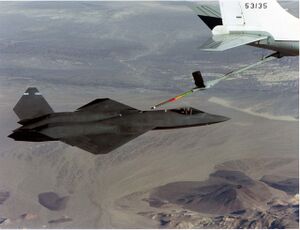K-40: Difference between revisions
No edit summary |
No edit summary |
||
| Line 19: | Line 19: | ||
}} | }} | ||
The | The K-40 Kestrel is the current Next Generation Fighter in use by most of the Concordat's Airforce, though the majority of early production aircraft are employed in the Kalaronian Airforce. Powered by two high-temperature OE-131 Turbofans, the Kestrel carries a larger weapon-payload than earlier stealthy designs produced by the Advanced Aeronautic Design Board of Velika Armaments. Designed to secure aerial supremacy in heavily reinforced airspace, the Kestrel has a secondary role in "cracking" that airspace open for less stealthy aircraft, aided by the introduction of the SVAM-13 "Small Volume Attack Missile" a year before it's adoption by Kalaron. | ||
Additionally, the K-40 remains the most mass-produced of Velika's stealth designs. Of the several hundred airframes produced, Kalaron retained the first one hundred to furnish it's squadrons, with a further fifty held and devoted to the Joint Concordat Defense Militia as per the Member Obligations. It's versatile design, excellent thermal and radar stealth, and superb maneuverability have led to it seeing international customers, even beyond the official Concordat Members in small numbers. | |||
==Background== | ==Background== | ||
Revision as of 07:15, 18 September 2020
| Type 40 fighter | |
|---|---|
 Three common Type 40 variants spanning the course of the war | |
| General information | |
| Type | Fighter |
| Designer | Chikai Aviation Company |
| Status | withdrawn from service |
| History | |
| Manufactured | 1939-1945 |
| Introduction date | 1940 |
The K-40 Kestrel is the current Next Generation Fighter in use by most of the Concordat's Airforce, though the majority of early production aircraft are employed in the Kalaronian Airforce. Powered by two high-temperature OE-131 Turbofans, the Kestrel carries a larger weapon-payload than earlier stealthy designs produced by the Advanced Aeronautic Design Board of Velika Armaments. Designed to secure aerial supremacy in heavily reinforced airspace, the Kestrel has a secondary role in "cracking" that airspace open for less stealthy aircraft, aided by the introduction of the SVAM-13 "Small Volume Attack Missile" a year before it's adoption by Kalaron.
Additionally, the K-40 remains the most mass-produced of Velika's stealth designs. Of the several hundred airframes produced, Kalaron retained the first one hundred to furnish it's squadrons, with a further fifty held and devoted to the Joint Concordat Defense Militia as per the Member Obligations. It's versatile design, excellent thermal and radar stealth, and superb maneuverability have led to it seeing international customers, even beyond the official Concordat Members in small numbers.
Background
Development
Design
Operational history
Early service
Anti-bomber operations
Post-war service
Variants
The prototype flown in the 1939 fighter competition was designated Chikai WH 25, with WH indicating wŏnhyŏng (prototype). Six were built. Its armament consisted of four 7.5mm machine guns: two above the nose, and one in each wing. Each gun was fed from a 500-round belt.
Type 40-I
Type 40-II
Type 40-III
Type 40-IV
Type 40-V
Specifications (Type 40-I)
<imgur thumb="yes" w="500">34yFV4y.png</imgur> General Characteristics
- Crew:
- Length:
- Wingspan:
- Height:
- Wing Area:
- Empty Weight:
- Loaded Weight:
- Powerplant:
Performance
- Maximum Speed:
- Range:
- Service Ceiling:
- Rate of Climb:
- Wing Loading:
- Power-to-Mass ratio:
Armament
- Guns:
- 2x forward-firing
- 2x forward-firing
- Bombs: